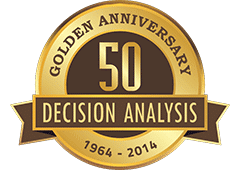What we learned in 50 years and how it applies to the 21st century
At a recent celebration of the 50th anniversary of the founding of the Decision Analysis (DA) profession, I summarized what we had learned and provided thoughts about the future of DA and its application in meeting today’s business challenges. I am pleased share some of these thoughts.
History
When DA was in its infancy, there were very few professional organizations for decision makers to call upon. I was lucky to be chosen as the leader of the Decision Analysis Group, a pioneering effort by the Stanford Research Institute (now SRI International) to explore and exploit the power of this new field. The SRI Decision Analysis Group thrived, and grew to over 40 people from 1966 to about 1980. We showcased our capabilities through an international series of executive seminars and learned how to become true consultants to top management, proving that Decision Analysis could indeed help create better, more profitable decisions.

In the early 1980s my colleagues and I formed the Strategic Decisions Group (SDG). At SDG we developed a global consulting practice and software systems for carrying out DA processes. Although the consulting paradigm worked well for complex one-of-a-kind decisions, corporate clients wanted ways to do more on their own. Some clients saw such high value-added that they developed internal capability. Others repurposed custom analysis software built during previous consulting work.
However, supporting customers doing their own analysis is quite different from helping clients approach their biggest decisions that involve major consulting interventions. This support requires building new capabilities into the customer organizations. This distinction led us to spin off SDG’s software activities into a new company, SmartOrg, which is dedicated to supporting clients with decision software and capability building. Since the founding of SmartOrg, we have seen a trend where leading organizations are adopting and internalizing Decision Analysis and DA-like approaches as a way to improve financial performance at departmental, divisional, corporate and global levels.
A second trend is the realization that opportunities should be consistently compared across the whole organization. Decision Analysis was proven early on to give great support to individual projects or opportunities, building insights, optimizing projects and reaching clear, committed action. But one-off analyses are difficult to compare across projects and across organizational “silos” as their analyses are designed to optimize project performance, not necessarily to compare opportunities with each other. However, comparing projects across portfolios, and across organizational units, rather than making isolated, one-off decisions, optimizes the financial performance of the whole organization and gives valuable feedback to how the performance of individual projects can be improved.
The secret of excellence in portfolio analysis is to create and use the same standards of analysis for each project in the portfolio, possibly including peer or expert review. This creates a level playing field for comparison, reaching sound conclusions that all participants are prepared to accept as fair. Standards include the use of cash flow methods and selection of discount rates, consistently vetting and capturing degrees of uncertainty, using a common expression of corporate risk attitude, etc.
Organizational comparisons should reach across silos. For example, the productivity of R&D projects can be compared with the productivity of marketing initiatives, capital improvements or acquisitions, etc., and funds can be shifted across the boundaries of silos to have the biggest impact on profitability, letting the various units compete for incremental investment funds. Portfolio comparisons can result in shifting funds over time, to support the best opportunities for creating value.
The most important new trick is to view the whole organization as a single value-generating machine to be globally and strategically optimized, rather than as individual buckets of responsibility.
Moving into the 21st century requires using the best consistent approach to decision-making as demonstrated by 50 years of the successful application of Decision Analysis.
[Editor’s note: This article was adopted from a longer article by Jim Matheson, a pioneer in the application of Decision Analysis (DA). He is a co-founder, CFO and Chairman of SmartOrg Inc., which provides consulting and software to support profitable growth and return on investment from R&D, NPD, innovation, capital investment and other opportunities.]



